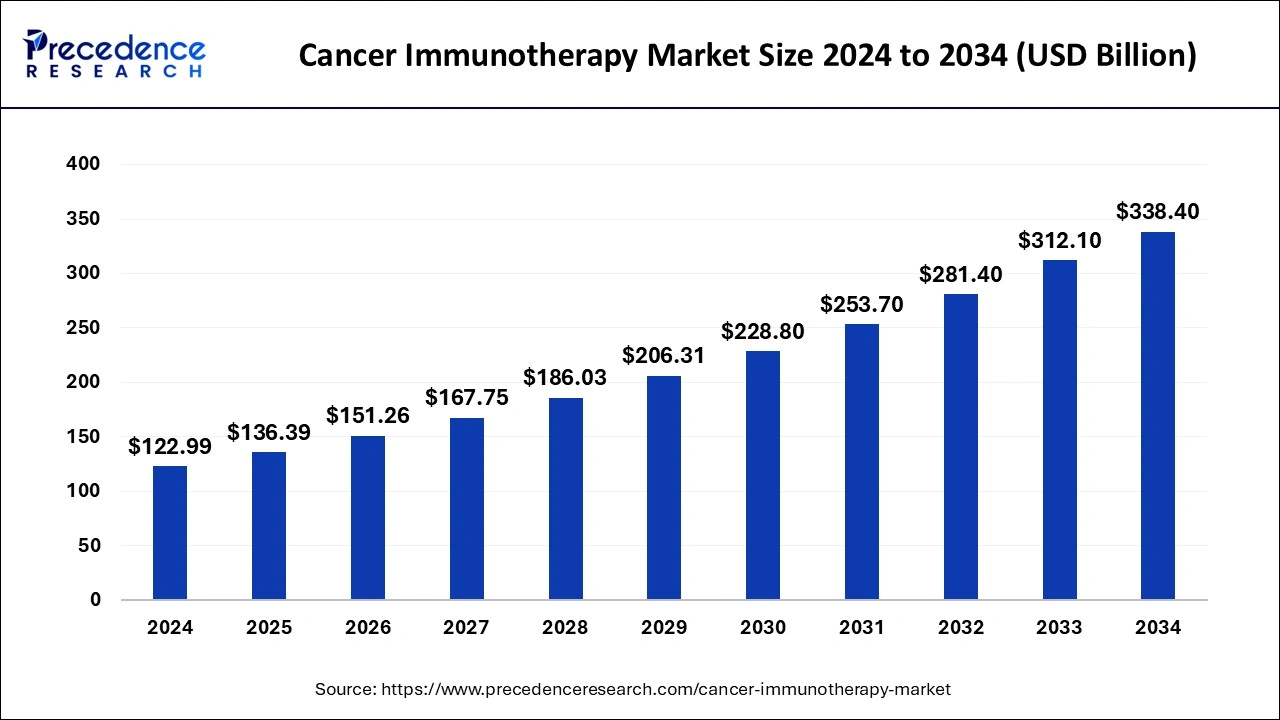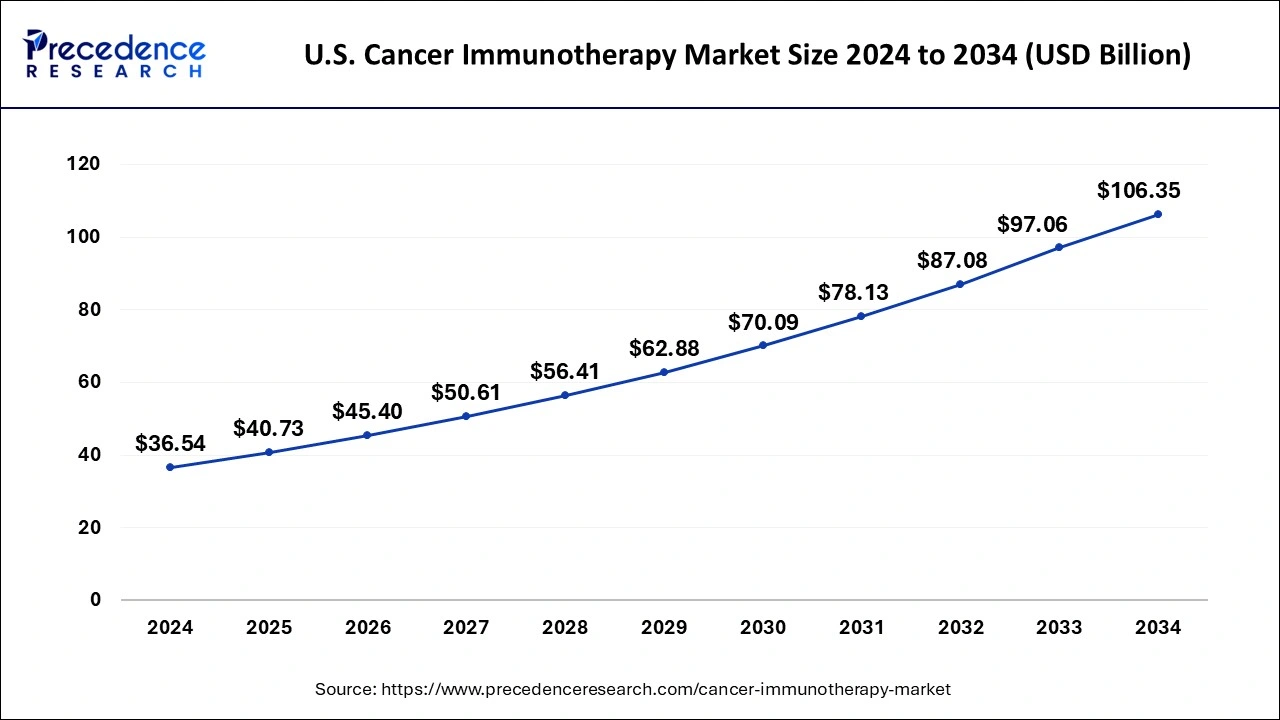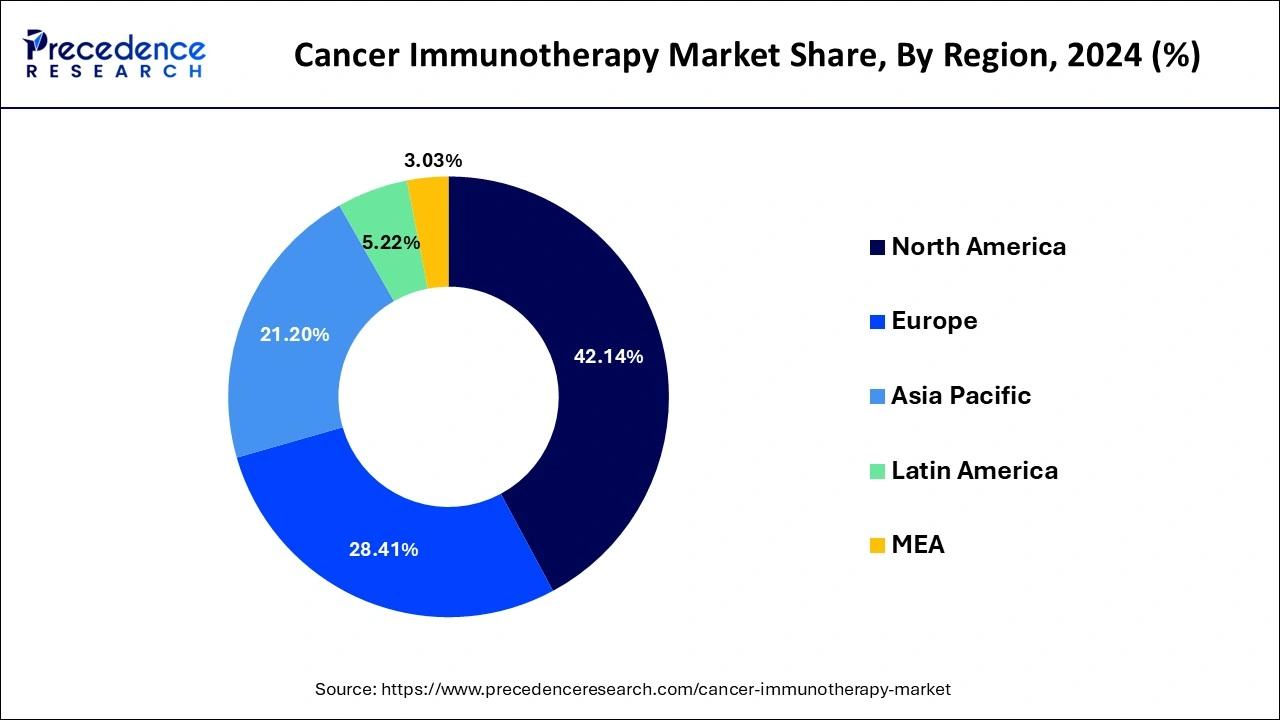List of Contents
Cancer Immunotherapy Market Size and Forecast 2026 to 2035
The global cancer immunotherapy market size is valued at USD 136.39 billion in 2025 and is predicted to increase from USD 151.26 billion in 2026 to approximately USD 367.63 billion by 2035, expanding at a CAGR of 10.42% from 2026 to 2035. The rising number of approvals by regulatory agencies for novel immunotherapies is anticipated to further help the growth of cancer immunotherapy market.

Cancer Immunotherapy Market Key Takeaways
- The North American region has contributed 42.14% revenue share in 2025.
- The Asia Pacific market is expected to grow at the fastest CAGR over the forecast period.
- By products, the monoclonal antibodies segment has held a revenue share of over 71.51% in 2025.
- By distribution channel, the hospital pharmacy segment has held a revenue share of 58.2% in 2025.
- By end-use, the hospital segment has held the largest revenue share of 67% in 2025.
Artificial Intelligence (AI) in cancer immunotherapy
Artificial Intelligence (AI) can be big boost for the cancer immunotherapy market in the coming years. AI has different applications that will help with various process of cancer immunotherapy treatment. Generative AI can be used for the development of mRNA-based cancer vaccines that are personalized. With generative AI, the development of superior mRNA molecules by uncovering potential sequence patterns as well as structure is possible. These AI based models will be able to provide an effective strategy for the designing on mRNA. Another benefit of utilizing AI is speeding up the drug discovery process for cancer. AI and machine learning (ML) model can run through numerous variations and analyze combinations that match while eliminating the rest. This gives researchers an edge in development of drug discovery by speeding up the process. There is plenty of scope for AI applications in the cancer immunotherapy market.
Market Overview
Cancer immunotherapy drugs are specifically created for boosting or altering human's body's natural immune response to fight diseases. This therapy is completely driven by research and developments efforts. Innovations by researchers and investment in research and developments have contributed to growth of the cancer immunotherapy market. The rising number of people and medical professionals opting for immunotherapy is rising day by day, helping the expansion of this market. This therapy is becoming a popular choice because it is cost-effective and has considerably less side effects from the treatments. Most key players are focusing on research and development activities to come up with novel treatments to help patients with cancer. These factors will drive the growth of cancer immunotherapy market in the forecast period.
Cancer Immunotherapy Market Growth Factors
- The global cancer immunotherapy market is primarily driven by the rising prevalence of cancer among the population and rising number of deaths associated with cancer disease. The global cancer cases are estimated to grow by 47% from 2020 to 2040.
- The traditional chemotherapy had certain disadvantages like organ failure and reoccurrence of cancer that drives the adoption of the new cancer immunotherapy among the patients.
- The technological advancements and development of new drugs has boosted the growth of the cancer immunotherapy market.
- The cancer immunotherapy directs the immune system to target the cancer affected cells and destroys the cancel cells. This therapy has less side effects and have long term treatment affects, which boosts the demand for the cancer immunotherapy across the globe.
Market Scope
| Report Highlights | Details |
| Market Size in 2026 | USD 151.26 Billion |
| Market Size in 2025 | USD 136.39 Billion |
| Market Size by 2035 | USD 367.63 Billion |
| Growth Rate from 2026 to 2035 | CAGR of 10.42% |
| Largest Market | North America |
| Base Year | 2025 |
| Forecast Period | 2026 to 2035 |
| Segments Covered | Technology, Cancer Type, and End User |
| Regions Covered | North America, Europe, Asia-Pacific, Latin America, and the Middle East & Africa |
Market Dynamics
Drivers
Rising cases of cancer
There is a noticeable increase in cases of cancer across the world. According to International Agency for Research on Cancer, in 2020, the number of cases were around 19.29 million and they estimate that in a decade by 2030, the number of cases will go up to 24.58 million. The change in lifestyle, rising ageing population combined with hereditary cancer cases rising are pushing the cancer cases up every passing year. This factor is a major driver for the cancer immunotherapy market and will continue to push market growth in the coming years.
Restraint
Clinical and Technological Challenges
Some clinical and technological challenges impose major limitations on the growth of the cancer immunotherapy market. Immune toxicities can develop side effects with severity ranging from autoimmune responses to cytokine storms, and therefore, patient monitoring and management require extreme care. Furthermore, while some patients even become resistant to immunotherapy, thus requiring combination therapies or alternative modes of therapy to sustain the treatment effect on the patient, these therapies themselves are steeply priced owing to complicated manufacturing procedures, especially of advanced therapies like cell-based therapies, such as CAR-T cell therapies, and logistics. Such hindrances have led to slow acceptance and use of immunotherapies, thus hindering the growth of the market.
Opportunity
Innovation
For this market, innovation is the key. It is only possible through research and development activities. The global cancer immune therapy market has already experienced a certain level of innovation and unique developments. The investments in research and development activities by key players have already made substantial progress with advancement in targeted therapies, customized treatments based on genetic profiles, precision medicine. These treatments offer different ways of helping patients fight cancer. In the forecast period, they key to further drive innovation is for major players to look for collaborations, acquisitions, partnerships etc. that can open up new avenues and geographical markets.
Cancer Immunotherapy Market Segment Insights
Technology Insights
Based on the technology, the monoclonal antibodies segment dominated the global cancer immunotherapy market in 2025, in terms of revenue and is estimated to sustain its dominance during the forecast period. The monoclonal antibodies are efficient in targeting the specific cancer affected cells and treats that particular cell without harming the normal cells. Therefore, it is considered safer and has low toxicity as compared to that of the chemotherapy. The low toxicity and low side-effects of the monoclonal antibodies is boosting its demand among the cancer patients. Further, a total 73 monoclonal antibodies has been approved by the end of 2017, by EMA and FDA.
On the other hand, the checkpoint inhibitors are estimated to be the fastest-growing segment during the forecast period. This can be attributed to the rising adoption of the checkpoint inhibitors in the treatment of the cancer. The development strategies adopted by the market players like collaborations for the research and development of the checkpoint inhibitors is expected to drive the demand for the checkpoint inhibitors during the forecast period.
Cancer Type Insights
Based on the application, the lungs cancer segment dominated the global cancer immunotherapy market in 2025, in terms of revenue and is estimated to sustain its dominance during the forecast period. This is simply attributed to the increased prevalence of lungs cancer among the global population. According to the International Agency for Research on Cancer, lungs cancer is the leading cause of cancer death across the globe. Around 1.8 million deaths were reported in 2020 due to the lungs cancer. It accounts for 18% of the global cancer deaths.
On the other hand, the breast cancer segment is estimated to be the fastest-growing segment during the forecast period. This can be attributed to the rapidly growing cases of breast cancer among the global women population. According to the International Agency for Cancer Research, breast cancer had surpassed the lungs cancer, by becoming the most diagnosed type of cancer. There were around 2.3 million or 11.7% of the new cancer cases reported as the breast cancer in 2020. Hence, this segment is expected to grow rapidly in the forthcoming years.
End User Insights
Based on the end user, the hospitals segment dominated the global cancer immunotherapy market in 2025, in terms of revenue and is estimated to sustain its dominance during the forecast period. This can be attributed to the increased number of hospital admission related to the treatment of cancer. Furthermore, the increased number of government and private hospitals in across the globe is the first preference of the patients to receive treatment for various types of cancer. The rising penetration of hospitals across the globe along with the rising adoption of the latest treatment technologies is expected to further drive the growth of this segment.
On the other hand, the cancer research institutions is estimated to be the most opportunistic segment during the forecast period. The rising corporate and government investments in the research and development of the cancer treatment therapies and research activities on the immunotherapies is expected to drive the growth of this segment in the upcoming future.
Distribution Insights
The segment for hospital pharmacies dominated the cancer immunotherapy market in 2025, with rising market demand for immunotherapies and more hospitalizations for cancer, mainly among patients above 65 years of age. The considerable complexity of cancer treatments and the higher hospitalization rates for elderly patients contribute almost equally to the considerable market hold of hospital pharmacies. Such hospital pharmacies provide critical access to specialist immunotherapy drugs for the care of patients inside clinical environments.
Over the forecast period, the online pharmacy segment is expected to record the highest CAGR. The rise is attributed to an increase in internet penetration, a boost to telemedicine use, and the time-saving convenience online platforms offer. Furthermore, large e-pharmacy operators providing a series of discounts and promotions increase the demand for it. These options together can increase the reach of a therapy to patients and make online pharmacies an increasingly valuable distribution channel for cancer immunotherapy markets.
Cancer Immunotherapy Market Regional Insights
The U.S. cancer immunotherapy market size is estimated at USD 40.73 billion in 2025 and is predicted to be worth around USD 116.10 billion by 2035, at a CAGR of 11.04% from 2026 to 2035.

What Made North America the Dominant Region in the Cancer Immunotherapy Market?
North America dominated the global cancer immunotherapy market in 2025, in terms of revenue and is estimated to sustain its dominance during the forecast period. This can be attributed to the increased prevalence of cancer in the region coupled with the increased adoption of the cancer immunotherapy among the population. According to the American Cancer Society, over 1.8 million new cancer cases and 606,520 deaths were reported in the US in 2020. The lungs cancer, colorectal cancer, breast cancer, and prostate cancer are the top four cancers that prevails in the US. However, owing to the increased adoption of the cancer therapies in the region, the number of cancer deaths has declined by 29% since 1991.
How is the Opportunistic Rise of Europe in the Cancer Immunotherapy Market?
On the other hand, Europe is estimated to be the most opportunistic market during the forecast period. This is due to the rising number of cancer cases and cancer deaths across Europe. According to the European Commission, around 2.7 million new cancer cases and around 1.3 million cancer deaths were reported in 2020. The geriatric population of aged 65 years or above were the most affected by cancer in Europe. Breast cancer has been recorded as the most diagnosed cancers across the European countries in 2023.

What Makes Asia Pacific the Fastest-Growing Area in the Cancer Immunotherapy Market?
Increasing cancer prevalence, increasing healthcare expenditure, and a growing governmental stance on cancer awareness and access to treatment are the paramount drivers driving growth in the Asia-Pacific cancer immunotherapy market. Countries that lead the regional market include China, Japan, and India, which have further developed infrastructure in healthcare and patient awareness. The acceptance of newer therapies, such as immune checkpoint inhibitors and CAR T-cell therapies, coexists with the ongoing clinical trials and approvals by the concerned regulatory bodies in the regions. Additionally, the region benefits from a large patient pool, along with reimbursement policies that facilitate access to treatments. The assertion for market opportunity comes from an increase in lifestyle cancers; meanwhile, along with immunotherapy developments, commercialization of precision medicines, and research collaborations lend a helping hand as well. There are challenges concerning equity and treatment costs. Nevertheless, local manufacturing capacities are rising, and digital health is getting integrated within the healthcare system positive to circumvent some of these concerns. Overall, due to technological advances, the Asia-Pacific market is expected to expand aggressively through 2030.
In the U.S., the market is being propelled by the increasing adoption of immune checkpoint inhibitors, cell-based therapies (such as CAR T), and therapeutic cancer vaccines, with a strong focus on personalized medicine driven by biomarker discovery and AI integration. The NIH-funded scientists and NCI researchers are working to launch and report several clinical trials that explore new immunotherapy approaches, treatment methods, and combination therapies. The U.S. has increased its international efforts by focusing on prevention and screening, and has many agreements with countries such as Sweden and the UK to share data and best practices.
German research institutions and biopharmaceutical companies are leading in immunotherapy research and clinical trials. The German Federal Ministry of Health announced the development of the national cancer plan in 2024, which aims to enhance overall cancer care, early detection, and treatment. Also, the country's robust healthcare infrastructure, supportive reimbursement frameworks, and active collaborations between biotech firms and academic institutions are accelerating adoption and innovation in the immunotherapy space.
In India, the market is accelerating due to rising cancer incidence, increased healthcare investment, and supportive government initiatives that expand access to advanced treatments. The Union Budget 2025-26 highlighted the Indian government's emphasis on healthcare, with the Ministry of Health and Family Welfare allocating Rs. 99,858.56 crore to enhance cancer care and research. In February 2025, the Union Minister of State for Health and Family Welfare announced that India planned to introduce a cancer vaccine for women within 5-6 months, which will target breast, oral, and cervical cancers.
Source: https://timesofindia.indiatimes.com
The market in Latin America is expected to grow at a moderate rate in the coming years. This is mainly because the government focuses on expanding access to proven treatments and gaining control over rising cancer rates. The key cancer immunotherapy drugs introduced by the World Health Organization (WHO) aim to improve access in South American countries. Brazil is likely to maintain its stronghold in the market. In January 2025, the Brazilian Ministry of Health announced new initiatives to improve cancer diagnosis and treatment. Moreover, in October 2025, Brazil's Minister of Health signed an agreement with a Chinese pharmaceutical company to jointly produce medicines for diabetes, cancer, obesity, and autoimmune diseases.
Source: https://tvbrics.com
The market in MEA is propelled by technological advancements in diagnostics and treatment options, along with the launch of new drugs. In April 2025, AstraZeneca announced its strategic move to adopt an equitable and sustainable approach to cancer care in Africa. Saudi Arabia is leading the market through major healthcare innovations, pharmacy chains, and a new cancer center.
- In October 2025, King Faisal Specialist Hospital and Research Centre (KFSHRC) showcased its leading role in Saudi Arabia's healthcare research and development scene through advances in gene therapy with local production of T-cells and plans to increase to 100 treatments per year.
Source: https://www.kfshrc.edu.sa
Cancer Immunotherapy MarketCompanies
- Amgen, Inc.
- Astrazeneca, PLC
- Bayer AG
- Bristol-Myers Squibb Company
- Eli Lily And Company
- F. Hoffmann-La Roche, Ltd
- Pfizer, Inc.
- Johnson & Johnson
- Merck KGAA
- Novartis AG
Recent Developments
- In January 2025, a team of researchers from Memorial Sloan Kettering Cancer Center (MSK) and the Tisch Cancer Institute at Mount Sinai, created an AI-based model called SCORPIO. This model is more affordable and accessible and it is also better at prediction of outcomes.
- In January 2025, CytoMed and SunAct announced that they were going to collaborate on cancer immunotherapy trials in India.
Cancer Immunotherapy Market Segments Covered in the Report
By Technology Type
- Monoclonal Antibodies
- Cytokines & Immunomodulators
- Checkpoint Inhibitors
- Others
By Cancer Type
- Lungs Cancer
- Colorectal Cancer
- Melanoma
- Breast Cancer
- Head & Neck Cancer
- Prostate Cancer
- Others
By End User
- Hospitals
- Clinics
- Cancer Research Centers
By Distribution Channel
- Hospital Pharmacy
- Retail Pharmacy
- Online Pharmacy
By Region
- North America
- Europe
- Asia-Pacific
- Latin America
- The Middle East and Africa
For inquiries regarding discounts, bulk purchases, or customization requests, please contact us at sales@precedenceresearch.com
Frequently Asked Questions
Ask For Sample
No cookie-cutter, only authentic analysis – take the 1st step to become a Precedence Research client